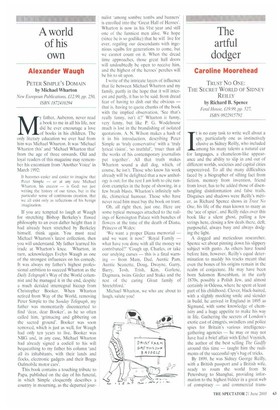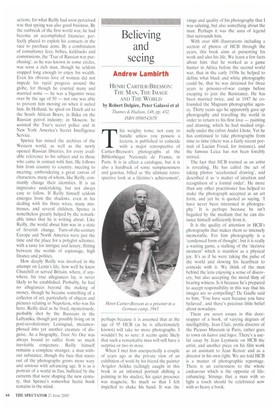The artful dodger
Caroline Moorehead
TRUST NO ONE: THE SECRET WORLD OF SIDNEY REILLY by Richard B. Spence Feral House, £19.99, pp. 527, ISBN 0922915792 It is no easy task to write well about a spy, particularly one as instinctively elusive as Sidney Reilly, who included among his many talents a natural ear for languages, a chameleon-like appearance and the ability to slip in and out of different worlds, societies and capital cities unperceived. To all the many difficulties faced by a biographer of sifting fact from fiction, memory from invention, friend from lover, has to be added those of disentangling disinformation and false trails. Disguises and shadows were Reilly's metier, as Richard Spence shows in Trust No One, his life of the man known to many as the 'ace of spies', and Reilly rides over this book like a silent ghost, pulling a few strings here, closing a few deals there, deft, purposeful, always busy and always dodging the light.
A dogged and meticulous researcher, Spence set about pinning down his slippery subject with gusto. As others have found before him, however, Reilly's equal determination to muddy his tracks meant that even the bones of his origins remain in the realm of conjecture. He may have been born Salomon Rosenblum, in the early 1870s, possibly a Polish Jew, and almost certainly in Odessa, where he spent at least part of his childhood. Clever, black-haired, with a slightly mocking smile and slender in build, he arrived in England in 1895 as Sigmund, with some knowledge of chemistry and a huge appetite to make his way in life. Gathering the secrets of London's exotic cast of émigrés, swindlers and police spies for Britain's various intelligencegathering agencies — he may or may not have had a brief affair with Ethel Voynich, the author of the best selling The Gadfly around this time — taught him the rudiments of the successful spy's bag of tricks.
By 1899, he was Sidney George Reilly, with a British passport and a British wife, ready to roam the world from St Petersburg to Shanghai, providing information to the highest bidder in a great web of conspiracy — and commercial trans
actions, for what Reilly had soon perceived was that spying was also good business. By the outbreak of the first world war, he had become an accomplished financier, perfectly placed to exploit his contacts in the race to purchase arms. By a combination of consultancy fees, bribes, kickbacks and commissions, the 'Tsar of Russian war purchasing', as he was known in some circles, was soon a rich man, though he seldom stopped long enough to enjoy his wealth. Even his obvious love of women did not impede his rapid progress around the globe, for though he courted many and married some — he was a bigamist twice over by the age of 50 — not one was able to prevent him moving on when it suited him. In Holland, he spied on Dutch aid to the South African Boers, in Baku on the Russian petrol industry: in Moscow, he assisted the Tsar's secret police and in New York America's Secret Intelligence Service.
Spence has mined the archives of the Western world, as well as the newly opened Russian libraries, for every available reference to his subject and to those who came in contact with him. He follows him from country to country, meeting to meeting, embroidering a great canvas of characters, many of whom, like Reilly, constantly change their identities. It is an impressive undertaking, but not always easy to follow. If Reilly himself seldom emerges from the shadows, even in his dealing with his three wives, many mistresses, and several children, Spence is nonetheless greatly helped by the remarkable times that he is writing about. Like Reilly, the world about him was in a state of feverish change. Turn-of-the-century Europe and North America were just the time and the place for a polyglot schemer, with a taste for intrigue and luxury, flitting between the worlds of espionage, high finance and politics.
How deeply Reilly was involved in the attempt on Lenin's life, how well he knew Churchill or served Britain, where, if anywhere, his true allegiances lay, is never likely to be established. Probably, he had no allegiances beyond the making of money, though he became something of a collector of art, particularly of objects and pictures relating to Napoleon, who was his hero. Reilly died as he lived, mysteriously, probably shot by the Russians in the Lubyanka, though just possibly living on in post-revolutionary Leningrad, metamorphosed into yet another creature of disguise. As a biography, Trust No One was always bound to suffer from so much inevitable conjecture. Reilly himself remains a complete stranger, a man without substance, though the face that stares out of the photographs grows more wary and anxious with advancing age. It is as a portrait of a world in flux, buffeted by the currents that were shaping the new century, that Spence's somewhat hectic book remains in the mind.



































































































 Previous page
Previous page